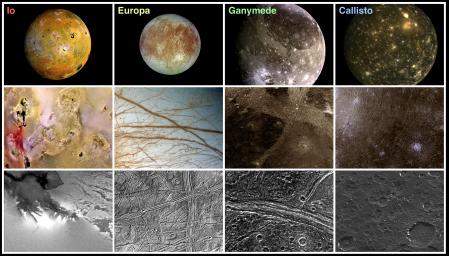
|
Landscape Comparisons - Galilean Satellites
- Click the image above for a larger view
- Full-Res JPEG (2290 x 1308) (605.1 kB)
- Full-Res TIFF (2290 x 1308) (6.4 MB)
Caption:
Each time NASA's Galileo spacecraft orbits the planet Jupiter, it encounters one of the four Galilean satellites. From left to right in this mosaic, the moons shown are Io, Europa, Ganymede, and Callisto. Throughout the eleven orbits in Galileo's nominal mission the Solid State Imaging (CCD) system builds up views of the satellite surfaces in different colors and at varying spatial resolutions.
The top row displays the correct relative sizes of the satellites in global views. In these relatively low resolution images the smallest features that can be seen are about 20 kilometers in size. These views show how the surfaces have been affected on the largest scales by either tectonic or volcanic changes in the interiors of the moons or by deposition from the exterior environment. In the middle row the picture resolutions are up to ten times higher and are suitable for investigations of the dominant regional features that are seen, such as fields of volcanic caulderas on Io (the black spots), tidally induced cracks thousands of kilometers long on Europa, bright grooved regions on Ganymede's extended surface, and enormous impact basins on Callisto due to hypervelocity impacts with primitive comets or asteroids. The bottom row displays views typical of the highest resolutions that have been achieved (up to about 20 meters) and which are used to study the nature and physical origins of individual structures on the surface, such as the individual vents from which volcanic plumes originate on Io, the ridges that are everywhere on Europa, the fractured and pulled apart grooved terrain on Ganymede, or the heavily eroded and mantled craters on Callisto.
The colors in several of these images represent views in spectral regions that are not visible to the eye. They show either differences in surface chemical composition or changes in the way the surface reflects sunlight. For example in the left middle image, bright red depicts material newly ejected from an active volcano on Io and the surrounding yellow materials are older sulphur deposits. The picture to its right shows enormous cracks in the ice shell that forms the surface of Europa. Blue represents ice and reddish areas probably represent a thin coating of darker material ejected by ice volcanoes that occur along the cracks.
Galileo has not yet completed its survey of the Galilean satellites (This will occur late in 1999 with a very close flyby of Io that should produce images of unprecedented resolution, up to 6 meters, on its surface.) and for this reason some of the images that have been used in this montage, such as the high resolution image showing individual volcanic vents on Io which shows details down to 350 meters in size, come from the previous mission to Jupiter, Voyager.
North is to the top of the pictures. The top row shows global color views of all satellites which have been scaled to about 10 kilometers (km) per picture element (pixel). The middle row shows regional color views, each covering an area about 1000 km by 750 km and scaled to about 1.8 km per pixel. The bottom row shows black and white views covering areas about 100 km by 75 km and scaled to about 180 meters per pixel. The Callisto global, Ganymede regional, and Io high resolution views were acquired in 1979 by NASA's Voyager spacecraft. Most of the images in this montage were acquired between June of 1996 and June of 1997 by the solid state imaging (CCD) system on NASA's Galileo spacecraft.
Background Info:
The Jet Propulsion Laboratory, Pasadena, CA manages the Galileo mission for NASA's Office of Space Science, Washington, DC. JPL is an operating division of California Institute of Technology (Caltech).
This image and other images and data received from Galileo are posted on the World Wide Web, on the Galileo mission home page at URL http://www.jpl.nasa.gov/galileo. Background information and educational context for the images can be found at URL http://www.jpl.nasa.gov/galileo/sepo
Cataloging Keywords:
| Name | Value | Additional Values |
|---|---|---|
| Target | Io | Callisto, Europa, Ganymede, Jupiter |
| System | Jupiter | |
| Target Type | Satellite | Planet |
| Mission | Galileo | Voyager |
| Instrument Host | Galileo Orbiter | |
| Host Type | Orbiter | Flyby Spacecraft |
| Instrument | Solid-State Imaging (SSI) | |
| Detector | ||
| Extra Keywords | Asteroid, Color, Comet, Crater, Impact, Plume, Volcano | |
| Acquisition Date | ||
| Release Date | 1998-02-04 | |
| Date in Caption | ||
| Image Credit | NASA/JPL/DLR | |
| Source | photojournal.jpl.nasa.gov/catalog/PIA00743 | |
| Identifier | PIA00743 | |
